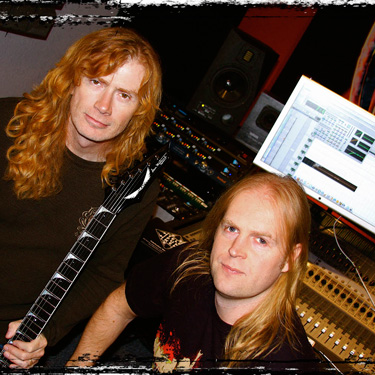|
 Megadeth front man, guitarist and songwriter, Dave Mustaine (left), with producer, engineer and long-time Metric Halo ChannelStrip user, producer, engineer, Andy Sneap. Megadeth front man, guitarist and songwriter, Dave Mustaine (left), with producer, engineer and long-time Metric Halo ChannelStrip user, producer, engineer, Andy Sneap.
SAN DIEGO, CALIFORNIA: Andy Sneap must surely be one of the hardest working men in metal, producing, engineering and mixing some of the best-known bands in the genre, including Testament, Killswitch Engage, Opeth, Nevermore, Exodus, Arch Enemy, Machine Head, and Megadeth. For Sneap, who also finds time to play guitar with Sabbat, the Nottingham, U.K.-based thrash metal band that he co-founded and reformed in 2006 after a fifteen-year hiatus, the one constant from project to project has been Metric Halo’s ChannelStrip plug-in.
“ChannelStrip’s compression is key to the whole drum sound that you hear on the albums that I do,” says Sneap, who uses the plug-in on every tracking and mixing project, whether at his Backstage Studios near Derby, England or elsewhere. “How clean I can get the drums with that plug-in is my main thing. I haven’t managed to get the same sort of smack out of any other compression that I use in Pro Tools.” It’s an essential tool for the type of music he produces, says Sneap, “Because you’re trying to get it so it’s as in your face as possible.”
Detailing ChannelStrip’s functionality, he continues, “The side chain function is really good and the EQ is easy to use. The interface is exceptional. I have my standard go-to settings when I’m tracking to keep everything clean as we’re listening to it. I just roll with it from there and tweak it as we go. The way that I work, I’ll do little things like use triggers to set off the side chain of the gates, which work really well. The attack on the gates seems really quick and really natural. It doesn’t seem to clip anything.”
Sneap recalls that he first used ChannelStrip while working at UB40’s DEP International Studios in Birmingham, England. “The engineer there recommended the plug-in. He said it was the closest thing he’d heard to an SSL-type compressor out of a plug-in. I used it on drums and it just blew me away. I’ve stuck with it ever since, from about 2000. It’s the sole plug-in that I use on my whole drum setup. To be honest, if I haven’t got it in the mix that I’m doing I’m pretty lost without it.”
But ChannelStrip isn’t solely restricted to drums. “It’s pretty good for vocals, as well,” he adds. “It warms things up quite nicely.”
Following a successful collaboration with Dave Mustaine and Megadeth in 2007 on the “United Abominations” album release, Sneap has signed up to work on the follow-up, which is being recorded at the band’s San Diego headquarters. Having arrived in Southern California in September to put the finishing touches on the band’s newly completed recording studio, named Vic’s Garage in honor of Vic Rattlehead, the iconic figure featured in most of Megadeth’s album artwork, Sneap says, “We’ve spent the last three weeks going through and fine-tuning it, putting the Pro Tools rig in and sorting all the acoustics out.”
The inaugural project at Vic’s Garage is a 5.1 mix for DVD of a live show that will also be broadcast on HDNet on November 2nd. That will be followed by two to three months of solid work on the new album before the band hits the road with Judas Priest in February 2009. ChannelStrip will be featured in both projects, which suits Sneap just fine. “The way I work now is all in the box,” he explains. “I tend to flit between so many different projects that trying to use a console and recall things is pointless for me now.”
Building a studio made sense financially. “The way that budgets have gone with record labels now, a record label now expects ninety minutes of music recorded in two months for a third of the price they paid in the ‘80s. You can build a studio now for a tenth of the price that you could fifteen years ago.” Part of that is keeping everything in the box, with a plug-in that performs just like the input strip of console, but without the cost. Plus, he says, “Then you’ve got the maintenance costs and the electricity bill on top, and you have to build a separate room for the power supplies.”
It made sense to base everything out of one building. “We have a big warehouse with all the gear in storage here, and all the offices and studio together. We’re going to run it as a commercial facility as well, just for bands that we know. There are a lot of projects in the U.S. that I haven’t ended up tracking because of the pound-to-dollar ratio. It was so expensive for bands coming to the U.K. to track with me, but now I have a U.S. base I can use for tracking, so it’s worked out well,” Sneap concludes. |